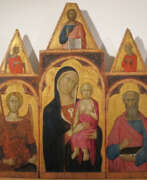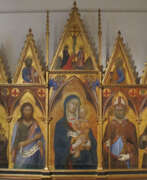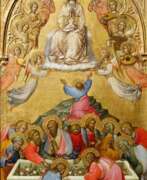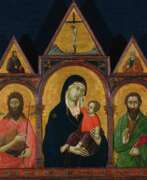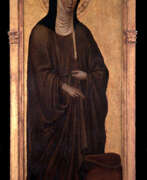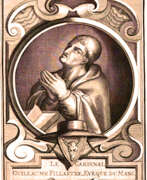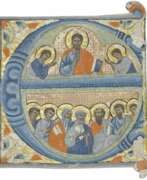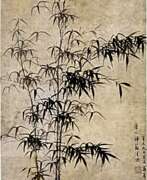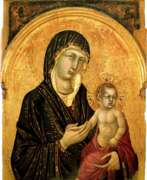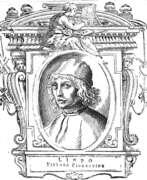14th century
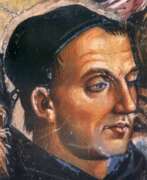

Fra Angelico, a name synonymous with the serenity and purity of Early Renaissance art, was a Dominican friar and Italian painter celebrated for his devout and luminous religious works. Born Guido di Pietro around 1395 in Vicchio, near Florence, he later became known as Fra Giovanni upon joining the Dominican order at Fiesole. His monastic life profoundly influenced his art, reflecting a deep spiritual commitment and a heavenly tranquility. Pope John Paul II recognized his sanctity by beatifying him in 1982, officially bestowing upon him the title "Blessed" and affirming his legacy as a bridge between heaven and earth through his art.
Fra Angelico's technical prowess and innovative approaches to composition and color set new standards in the art world. He was initially trained as an illuminator, which is evident in the delicate details and luminous quality of his works. His art was not confined by his religious duties; instead, his position allowed him to advance the Dominican order's mission through visually compelling narratives that spoke directly to the viewer's soul. His works, including altarpieces and frescoes, are revered for their serene religious attitude and classical influence, embodying the Early Renaissance spirit that sought to harmonize Christian themes with the natural world and human emotion.
Among his most notable contributions are the frescoes at the convent of San Marco in Florence, commissioned by Cosimo de' Medici. These works display Angelico's mastery over perspective and his ability to create a spiritual atmosphere that invites contemplation. The Annunciation, one of his most famous frescoes at San Marco, exemplifies his use of architectural space to frame the sacred narrative, integrating the divine with the everyday. His altarpieces, characterized by their detailed figures and harmonious compositions, were innovative in their unified presentation of sacred stories, moving away from the segmented Gothic style towards a more cohesive and immersive narrative experience.
Fra Angelico's influence extended beyond his lifetime, shaping the trajectory of Renaissance art through his integration of humanistic principles with devout Christian faith. His works are preserved in some of the world's most prestigious museums, including the Museo Diocesano in Cortona, the Uffizi Gallery, and the Museo del Convento di San Marco in Florence, continuing to inspire awe and reverence among viewers.
For collectors and experts in art and antiques, the legacy of Fra Angelico offers a window into the soul of the Renaissance, where beauty and spirituality converge. To stay informed about new product sales and auction events related to this pivotal artist, signing up for updates is a prudent step towards enriching one's collection with works that embody the zenith of religious and artistic expression in the Early Renaissance.


Ferrer Bassa was a renowned Catalan Gothic painter and miniaturist, active in the early 14th century. His artistry not only graced the courts of Aragon but also laid the foundations of the Catalan School of painting. Bassa is celebrated for integrating the traditional Gothic style with French and Sienese influences, creating a unique visual lexicon that was ahead of his time.
Born around 1285, Bassa's career highlights include his work for Alfonso IV of Aragon and the impactful series of frescos in the St. Michael Chapel at the Monastery of Pedralbes in Barcelona. These frescos, executed between 1345-46, are Bassa's most significant surviving works. They showcase an Italianate style, featuring around twenty scenes that focus on the Passion of Christ and the Seven Pains of the Virgin. His work in the Great Canterbury Psalter also stands as a testament to his exemplary skills.
Bassa's contribution to the world of art extends beyond his own creations. He played a pivotal role in the evolution of the Catalan phase of Gothic painting, significantly influencing the period's artistic direction. His legacy was furthered by his son, Arnau Bassa, who continued his father's artistic journey.
For art collectors and enthusiasts, the works of Ferrer Bassa are more than historical artifacts; they are the keystones of Catalan Gothic art. His influence resonates in the works of subsequent artists and continues to inspire modern artistic expressions. For those wishing to delve deeper into the rich tapestry of Gothic art, Ferrer Bassa's works are an indispensable resource.
To stay informed about upcoming sales and auction events featuring Ferrer Bassa's works, we invite you to sign up for our updates. This subscription is tailored for enthusiasts and collectors like you, ensuring you never miss an opportunity to own a piece of this illustrious artist's legacy.


Pierre Bersuire, also known as Petrus Berchorius, was a French medieval writer, Benedictine monk, translator, and encyclopedist.
He was the leading French scholar of his time and friend of Petrarch, author of encyclopedic works on morality, and the first French translator of Titus Livy's History from the Foundation of the City. Very interesting for researchers is Pierre Bersuir's text Ovidius Moralisatus - written in Avignon in 1340 and spreading rapidly, it is a systematic allegorical analysis of the Metamorphoses, aimed at the current situation in church and society.
Bersuire was also an eloquent preacher and author of voluminous sermons.


Giovanni Boccaccio was an Italian humanist scholar, writer and poet of the Early Renaissance.
Boccaccio was the son of a Tuscan merchant who sent him to Naples to study business and law. Giovanni revolved in aristocratic circles there and became acquainted with Petrarch's work. In Naples he wrote his first works of poetry, raising the poetry of Italian minstrelsy to literature. Returning to Florence in 1341, Boccaccio, in addition to the famous book of witty short stories "Decameron" (1348-1353), created many poems, allegories and prose works.
In 1350 at Bocaccio's house in Florence, he met Petrarch, which developed into a friendship. In the last years of his life he concentrated on scholarly works in Latin, including writing De montibus, silvis, fontibus, lacubus..., - this alphabetical list of mountains, forests, rivers and lakes was based on the writings of ancient poets. His other Latin works include the philosophical and historical De claris mulieribus (a collection of biographies of famous women, 1360-74) and De casibus virorum illustrium (On the Fates of Famous Men, 1355-74).
Giovanni Boccaccio had a significant influence on the development of all European culture through his work. Together with Petrarch, he laid the foundations of Renaissance humanism and raised popular literature to the level and status of the ancient classics.


Lluís Borrassà, a prominent Catalan painter, is renowned for revolutionizing the Gothic painting style in Catalonia. Born around 1360 in Girona and possibly deceased in 1426 in Barcelona, Borrassà's contribution to the art world is immeasurable. He was notably employed by the Crown of Aragon, an association that not only enhanced his prestige but also facilitated the spread of his unique artistic style.
Borrassà's art is distinguished by its embodiment of the International Gothic painting style, a movement he is credited with introducing to Catalonia. His works are characterized by their vibrant colors and detailed depictions, elements that were innovative for his time. This distinctive style set a new standard in the region, influencing many subsequent artists and marking a pivotal point in the history of Catalan art.
Among Borrassà's notable works are the panels of the 'Profession of Saint Peter the Martyr' and the 'Beheading of the Relatives of Sant Hipòlit', both of which are now treasured parts of the Gothic art collection at the Museu Nacional d'Art de Catalunya. These artworks not only showcase Borrassà's mastery of color and detail but also provide a window into the cultural and historical context of the period.
For art collectors and experts, Borrassà's work represents a significant chapter in the evolution of European art, particularly within the Gothic tradition. His paintings are not just visual treats but are also rich in historical value, offering insights into the cultural and artistic landscape of 14th and 15th century Catalonia.
To stay updated on sales and auction events related to Lluís Borrassà's works, sign up for our updates. This subscription is specifically tailored for enthusiasts interested in the confluence of art, history, and culture, focusing exclusively on news related to Borrassà's art.


Bartolomeo Bulgarini (also Bartolomeo Bolgarini) was an Italian painter of the Sienese School. Before he could be identified by name and his work classified, some of his paintings were grouped in art history under the pseudonyms Ugolino Lorenzetti or Master of Ovile.


Geoffrey Chaucer was a medieval English poet and novelist, one of the founders of the literary English language.
Geoffrey Chaucer came from a wealthy family, in 1357 became a civil servant of Countess Elizabeth of Ulster and remained at the British court all his life. Later in his royal service, he traveled on diplomatic missions to France, Spain, and Italy. He made important contributions to the management of public affairs as a courtier, diplomat and civil servant. And very importantly, in these travels Chaucer was exposed to the works of Dante, Petrarch and Boccaccio, which later had a profound influence on his writing.
"The Canterbury Tales" became Geoffrey Chaucer's most famous and recognized work, although this voluminous work remained unfinished. He also wrote the popular science treatise "A Treatise on the Astrolabe", the historical poems "Troilus and Criseyde" and "Legends of Glorious Women", and many poems.
Geoffrey Chaucer is called the forerunner of the literature of the English Renaissance. He was the first to write works in his native language instead of Latin, for which he earned the title of "father of English poetry." Chaucer was buried in Westminster Abbey, and his grave became the first in the so-called "Poet's Corner", where Charles Dickens, Rudyard Kipling and Alfred Tennyson were later buried.


Cimabue, a preeminent Italian painter and mosaicist from the late 13th century, remains a pivotal figure in the transition from the Byzantine to the early Renaissance art style. Born before 1251 and passing in 1302, his works are celebrated for their innovative departure from the Italo-Byzantine conventions, introducing more naturalistic forms and expressions into Western European painting. This transformative approach is evident in his frescoes in the Basilica of San Francesco, Assisi, and the Santa Trinita 'Maestà' now housed in the Uffizi Gallery, Florence.
Cimabue's significance in art history is underscored by his role in laying the groundwork for the evolution of Italian painting, marking a critical moment when artists began exploring the depiction of three-dimensional space and the naturalistic rendering of forms. His influence extended to his contemporaries and successors, notably Giotto, who is often credited with advancing the Renaissance style that Cimabue initiated.
One of Cimabue's most notable works, the Santa Trinita 'Maestà', exemplifies his mature style with its refined use of perspective and more humanistic portrayal of figures, moving away from the rigid Byzantine models. This painting, alongside his frescoes in Assisi and the mosaic of 'Saint John the Evangelist' in Pisa's cathedral, demonstrates his pioneering role in the early Italian Renaissance. Despite being eventually eclipsed by Giotto, Cimabue's legacy as a bridge between Byzantine traditions and the nascent Renaissance cannot be understated.
Cimabue's artwork not only represents a crucial pivot in art history but also continues to captivate collectors and experts in art and antiques for its historical significance and the foundational role it played in the development of Western art. For those keen on exploring the origins of Renaissance art, Cimabue's works offer invaluable insights into the period's artistic evolution.
For aficionados and connoisseurs deeply engaged in the realms of art history and antique collection, particularly those with a keen interest in the seminal period that bridges the Byzantine and Renaissance eras, staying informed on Cimabue's artistic legacy is invaluable. To this end, we cordially invite you to subscribe to our dedicated updates. This subscription service is designed to provide enthusiasts with exclusive notifications about new discoveries, forthcoming sales, and prestigious auction events directly related to Cimabue's remarkable oeuvre. Engage with us to ensure you remain at the forefront of significant developments and opportunities to enhance your collection with works from this foundational figure in art history.


Gentile da Fabriano was an Italian painter known for his participation in the International Gothic painter style. He worked in various places in central Italy, mostly in Tuscany. His best-known works are his Adoration of the Magi from the Strozzi Altarpiece (1423), and the Flight into Egypt. Following a visit to Florence in the 1419, he came in contact with humanism, which influenced his work throughout the rest of his career. He became highly influential for other painters in Florence, especially because of his use of detail based on the observations he made of the natural world.


Barnaba da Modena, born Barnaba Agocchiari, was an influential Italian painter from Modena who played a pivotal role in the art scene of mid-14th-century Italy. His work is renowned for embodying the Byzantine art style, making him the first notable Lombard painter. Throughout his career, Barnaba was predominantly active in Lombardy, Piedmont, and even ventured into Pisa in Tuscany, showcasing his diverse geographical influence.
Barnaba's painting style was deeply rooted in Byzantine traditions, characterized by the use of gold highlights and golden backgrounds. He was adept at creating compositions that adhered to the older, more traditional styles of painting, which remained exceedingly popular in Genoa. This adherence to Byzantine painting techniques contributed significantly to his success in Genoa, as it resonated with the stylistic preferences of the time. His work often featured religious themes, executed with a depth of feeling and a refined technique that distinguished him from his contemporaries.
His extensive body of work includes about 50 known pieces, many of which are held in high regard for their technical and artistic quality. Notable works by Barnaba da Modena are preserved in prestigious institutions, including the National Gallery in London and The Courtauld, London. These works, such as "Virgin and Child" and "Pentecost," reflect his profound influence on the Genoese and possibly Pisan art scenes of the late 14th century. His follower, Nicolò da Voltri, continued Barnaba's stylistic legacy well into the 15th century, particularly in Liguria.
For collectors and experts in art and antiques, Barnaba da Modena's paintings offer a unique window into the transition between Medieval and Renaissance art, marked by his exceptional blending of Byzantine and Italian Gothic elements. His ability to convey religious narratives through meticulous detail and vibrant gold accents make his works a valuable addition to any collection.
To stay informed about new discoveries, sales, and auction events related to Barnaba da Modena's works, signing up for updates is advisable. This subscription will provide exclusive access to the latest information on this masterful painter, enriching your collection with significant pieces from the mid-14th century Italian art scene.


Bernardo Daddi, an Italian painter born in the late 13th century, emerged as a pivotal figure in the early Renaissance, particularly within the Florentine school of painting. Operating in Florence between 1280 and 1348, Daddi's oeuvre is renowned for its devout spiritual essence and the delicate finesse of its execution, marking a significant departure from the Byzantine traditions that dominated the era.
Daddi's art is distinguished by its intimate scale, refined attention to detail, and vibrant narrative compositions, which were primarily religious in nature. His works are celebrated for their clarity, color, and emotional depth, contributing to the evolution of painting during a period rich in cultural and artistic exploration. Among his notable contributions, the "Madonna and Child" triptychs and frescoes in Florence stand as testaments to his skill and spiritual devotion.
Bernardo Daddi's influence extended beyond his lifetime, setting the stage for the blossoming of Renaissance art. His paintings, housed in prestigious museums and churches, offer a window into the soul of 14th-century Italy, reflecting the period's complex interplay between faith, art, and society.
For collectors and art history aficionados, Daddi's works represent not just aesthetic achievements but also historical artifacts that capture the essence of an era on the cusp of the Renaissance. His legacy, embedded in the fabric of Italian art history, continues to inspire and captivate those who seek to unravel the origins of Renaissance painting.
Intrigued by Bernardo Daddi's mastery and his contribution to the dawn of the Renaissance? Sign up for updates to stay informed about the latest sales, exhibitions, and auction events featuring his work. This subscription is your gateway to the world of art collecting, offering exclusive insights into opportunities to own a piece of history.


Jean Charlier de Gerson was a French academic, theologian, preacher and politician of the 14th and 15th centuries.
Jean Charlier de Gerson was Chancellor of the University of Paris from 1395 until 1415, and as such played a major role in the political troubles between the Duke of Orleans and the Duke of Burgundy, subsequently known as the Armagnacs and Burgundians, as well as in the crisis arising from the Great Western Schism.


Pol de Limburg, also Paul van Lymborch or van Limburg, was an early 15th-century French miniaturist from the Northern Netherlands.
Together with his two brothers, Herman and Jean, Pol worked in Paris. As teenagers, all three entered the service of Jean de France, Duc de Berry. It was for him that two of the most lavishly illustrated books of hours (a popular form of private prayer book at the time) were created.
Pol evidently had the greatest skill among the brothers and to him belongs the bulk of the work. After the completion of the Red Gazetteers, the brothers set to work on the Duke de Berry's Three Rich Gazetteers. This work, considered their greatest creation, belongs among the finest examples of the International Gothic style.
The Limburg brothers left The Rich Days of the Duke de Berry unfinished, as they died almost simultaneously in 1416, possibly during a plague epidemic.
The Limbourg brothers are the best known of all late Gothic manuscript illuminators. Together they synthesized the innovations of other illuminators and developed a style of their own, characterized by fine lines, painstaking technique, and minute detail. Their "Rich Days of the Duc de Berry," completed about 1485 by Jean Collomb, is one of the milestones in the art of book illumination. It greatly influenced the course of early book illumination and foreshadowed the paths of Northern Renaissance art.


Giovanni del Biondo, an Italian painter active in the 14th century, was a distinguished figure in the vibrant tapestry of medieval art. Originating from Florence, he was known for his devout religious paintings that adorned many churches and sacred spaces throughout Italy. His specialization in altarpieces and frescoes captured the essence of divine narratives with a profound sense of piety and devotion.
Del Biondo's art is celebrated for its meticulous attention to detail, vibrant colors, and the emotional depth of its subjects. He had a unique ability to convey complex theological themes through his works, making them not only visually stunning but also spiritually enriching. His contributions to the Gothic style of painting helped pave the way for the forthcoming Renaissance by infusing traditional religious art with a new sense of naturalism and humanism.
Among his known works, the altarpieces depicting scenes from the life of Christ and the Virgin Mary are particularly noteworthy. These masterpieces, housed in museums and churches across Europe, continue to captivate art lovers with their elegance and intricacy. Giovanni del Biondo's legacy as a master painter lies in his ability to transcend the boundaries of time, inviting viewers into a contemplative dialogue with the divine.
For collectors and experts in art and antiques, Giovanni del Biondo represents an intriguing chapter in the history of art. His works offer a glimpse into the spiritual and artistic aspirations of medieval Florence, providing a rich field for exploration and appreciation.
To stay informed about the latest discoveries, exhibitions, and auction events featuring Giovanni del Biondo's works, signing up for updates is essential. This subscription will ensure that enthusiasts and collectors alike are always at the forefront of new opportunities to engage with the art of this medieval maestro.


Giotto di Bondone, an Italian painter and architect, emerged as a pivotal figure in the transition from medieval to Renaissance art. His mastery in painting is best exemplified in the Scrovegni Chapel in Padua, also known as the Arena Chapel, where his fresco cycle depicting the Life of the Virgin and the Life of Christ is considered a seminal work of the Early Renaissance. This chapel, completed around 1305, highlights Giotto's innovative approach to art, breaking away from the Byzantine style that dominated the period. His techniques in depicting life and emotion in his works were revolutionary, setting a new direction in Western art.
Despite his acclaimed works, many aspects of Giotto's life remain shrouded in mystery and controversy, including his exact birthplace and the full extent of his apprenticeship. Traditionally believed to have been born in a farmhouse in either Colle di Romagnano or Romignano, recent research suggests he was born in Florence, the son of a blacksmith. His birth year is also uncertain, with estimates ranging from 1266/67 to 1276.
Giotto's early life, as narrated by Giorgio Vasari, is filled with anecdotal charm. He was supposedly discovered by the renowned Florentine painter Cimabue while drawing pictures of his sheep on a rock, so lifelike that Cimabue immediately recognized his talent. This encounter led to Giotto's apprenticeship under Cimabue, although this story, like many others about his early life, is debated by scholars.
In addition to the Scrovegni Chapel, Giotto's notable works include the decoration of various chapels and churches across Italy, such as in Assisi, Rome, Florence, and Naples. His Crucifixion panel and the Nativity scene are particularly celebrated for their depth and emotional intensity. Giotto was also an architect; in 1334, he was chosen to design the campanile of the Florence Cathedral, reflecting his reputation as a foremost artist.
Giotto's influence extended beyond his lifetime, inspiring future Renaissance artists with his naturalistic representation of human figures and his skill in conveying perspective and emotion. His works in the Peruzzi Chapel in Florence, particularly the Life of St. John the Baptist, are examples of this legacy.
In summary, Giotto di Bondone stands as a monumental figure in art history, his contributions marking the dawn of the Renaissance and forever altering the course of Western art. His ability to infuse his works with realism and emotional depth set a new standard in artistic expression, influencing generations of artists to come.
For those interested in the art and history of Giotto di Bondone, updates on new product sales and auction events related to his work are available. Sign up to stay informed about these opportunities and to deepen your appreciation of this pivotal artist's legacy.


Duccio di Buoninsegna, a master Italian painter from the late 13th and early 14th centuries, is celebrated as a pivotal figure in the Sienese school of painting. His birth and career in Siena profoundly influenced Italian medieval art, especially through his integration of the Italo-Byzantine tradition's formality with the Gothic style's emerging spirituality.
Duccio di Buoninsegna’s artworks are predominantly wood panel paintings, utilizing egg tempera and gold leaf, reflective of the period's artistic practices. His innovative approach is noted for its delicacy and precision in tempera, a marked contrast to the techniques of his contemporaries. Duccio di Buoninsegna is credited with softening the rigid lines of Byzantine art, rendering figures more rounded and three-dimensional, and employing modeling to enhance light and shadow effects, lending depth and realism to his subjects.
Among Duccio di Buoninsegna’s most significant works are the "Rucellai Madonna" at the Galleria degli Uffizi and the "Maestà", an altarpiece for Siena Cathedral. These dated and major public commissions, particularly the Maestà, created between 1308 and 1311, stand out as extraordinary achievements. The Maestà is a large and complex altarpiece, painted on both sides with about eighty separate scenes, showcasing Duccio di Buoninsegna’s intricate and detailed style.
Duccio di Buoninsegna's influence extended to numerous artists, including Simone Martini and the brothers Ambrogio and Pietro Lorenzetti. He had several followers, ranging from actual pupils in his workshop to artists simply inspired by his style. This includes artists from the first generation of followers active between 1290 and 1320, and a second generation active between about 1300 and 1335. His influence continued to shape Sienese and Tuscan painting well after his death.
For art collectors and experts, Duccio di Buoninsegna’s work represents a critical moment in Western art's evolution. His nuanced approach to religious themes and pioneering techniques make his works highly valued in the art and antiques world.
If you are passionate about the history and works of Duccio di Buoninsegna, consider signing up for updates. This subscription will keep you informed about new product sales and auction events related to Duccio di Buoninsegna's art, ensuring you stay connected to the legacy of this remarkable Sienese master.


Tino di Camaino was an Italian sculptor.
He was a pupil of Giovanni Pisano, whom he helped work on the façade of the Cathedral of Siena. Later Tino followed his master to Pisa, where in 1311 he became responsible for the work on the cathedral.
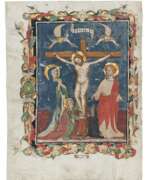

Jacopo di Paolo was an Italian painter and illuminator who worked in Bologna during the fourth and fifth centuries.
Jacopo was a very versatile artist, working in several of the city's famous decorative studios and collaborating with sculptors to create drawings for sculptures. He was also involved at various levels in the political and cultural life of the city. Jacopo was enrolled in the Guild of Artists and Jewelers and held many public positions in Bologna. Jacopo's influence in Bologna lasted for half a century and his three sons also became artists.


Niccolò di Pietro Gerini was a pivotal figure in the Italian art scene of the late Gothic period, celebrated for his contributions that spanned from the late 14th to the early 15th century. Born in Florence around 1340, Gerini's artistry flourished within the walls of his native city, although his talent also led him to work in Pisa and Prato. Unlike the innovative currents that swept through the art world during his time, Gerini remained faithful to traditional compositions, favoring stiff and dramatic movements in his figures.
Gerini's education and career were deeply intertwined with the artistic guilds of Florence. His father's membership in the Guild of Saint Luke in 1339 paved the way for Gerini's own entry into the Arte dei Medici e Speziali Guild by 1368, a testament to his early involvement in the city's artistic fabric. His works, marked by their large chins, sloping foreheads, and sharp noses, bore the influence of Gothic depictions, aligning him with the schools of Giotto di Bondone, Andrea di Orcagna, and Taddeo Gaddi.
Throughout his career, Gerini collaborated with notable artists like Jacopo di Cione, contributing to frescoes for the Guild hall of the Judges and Notaries in Florence and working on significant projects such as the altarpiece for the Coronation of the Virgin at San Pier Maggiore, Florence. His ability to blend architectural design with his painting skill is evident in these collaborations.
Gerini's paintings, including the triptych from 1387 housed in the National Gallery, London, and the Crucifixion, showcase his mastery over egg tempera on wood, a medium through which he conveyed religious narratives with profound solemnity and intricate detail. His works are preserved in prestigious collections, including The Hermitage, St. Petersburg, and the Alte Pinakothek, Munich, reflecting his enduring legacy in the annals of art history.
For collectors and experts in art and antiques, Gerini's oeuvre offers a rich exploration of late Gothic artistry, characterized by its adherence to traditional values while simultaneously capturing the spiritual and cultural nuances of his time. To stay informed on new discoveries and auction events related to Niccolò di Pietro Gerini, signing up for updates is a valuable resource for enthusiasts keen on this remarkable period of art history.


Taddeo Gaddi was a renowned medieval Italian painter and architect. He was a pupil and a most faithful follower of the illustrious Florentine master Giotto. Despite lacking Giotto’s comprehensive aesthetic vision, Gaddi emerged as the leading Florentine painter for three decades following his mentor's death.
Taddeo Gaddi’s most acclaimed work is the cycle of 'Stories of the Virgin' in the Baroncelli Chapel of the Basilica of Santa Croce in Florence, created between 1328 and 1338. This work is celebrated for its dynamism, pronounced foreshortening, dramatic effects of light, and an interest in narrative, showcasing his expertise in both painting and architectural elements. He is also credited with painting the cabinet tiles in the sacristy of the same church, now divided among several museums including the Galleria dell'Accademia in Florence, and museums in Munich and Berlin.
Taddeo Gaddi's style shows a clear influence from his master Giotto, yet he added his own experimentation, particularly in architectural backgrounds. His works, such as the ‘Madonna in Bern’, ‘Adoration of the Magi in Dijon’, and ‘Stories of Job’ in Pisa, demonstrate his mastery of Giotto's new style. He also contributed works like 'The Stigmatization of Saint Francis' to Harvard Art Museums, and 'Madonna del Parto' and 'Polyptych in Santa Felicita's sacristy' in Florence.
Taddeo Gaddi enjoyed a comfortable economic situation throughout his life, especially in his later years. He passed away in 1366 and was buried in Santa Croce, leaving behind a legacy as one of the most influential men in Florentine artistic culture. His work in the Basilica Santa Croce provides a canonical viewing of Gaddi’s style and his proficiency with color and light.
For collectors and experts in art and antiques, Taddeo Gaddi's works offer an important perspective on the transition from medieval to Renaissance art in Florence. His blend of Giotto's influence with his unique approach to color and narrative makes his works a valuable addition to any collection that values the rich history of Florentine art.
To stay updated on sales, exhibitions, and auction events related to Taddeo Gaddi's art, consider signing up for updates. This subscription will provide you with the latest information on acquiring pieces from this influential Florentine artist.


Pietro Lorenzetti was an Italian painter whose innovative contributions to the Sienese school of art marked a significant departure from the Byzantine style of the medieval period. Born in Siena, Lorenzetti was known for his detailed and expressive approach to painting, which helped lay the groundwork for the Italian Renaissance.
Renowned for his mastery in depicting light, shadow, and space, Lorenzetti introduced a sense of depth and realism previously unseen in Italian art. His works are characterized by a rich color palette and a keen observation of the human condition, rendering scenes with emotional depth and a tangible sense of atmosphere.
Among his most celebrated works is the "Birth of the Virgin" fresco in the Siena Cathedral, a masterpiece that showcases his ability to weave narrative and decoration into a cohesive whole. Lorenzetti's religious paintings, which are housed in various museums and churches, remain pivotal in understanding the evolution of European art during the 14th century.
For collectors and experts in art and antiques, Pietro Lorenzetti represents a fascinating study in the transition from medieval to Renaissance art. His contributions not only enriched the Italian artistic heritage but also influenced generations of artists to come.
To explore the legacy of Pietro Lorenzetti and stay informed about the latest research, exhibitions, and auction events featuring his work, signing up for updates is essential. This subscription will ensure that aficionados and collectors alike are always connected to the vibrant world of Sienese painting, offering exclusive insights and opportunities to appreciate the art of this pioneering master.


Ambrogio Lorenzetti or Ambruogio Laurati was an Italian painter of the Sienese school. He was active from approximately 1317 to 1348. He painted The Allegory of Good and Bad Government in the Sala dei Nove (Salon of Nine or Council Room) in Siena's Palazzo Pubblico. His elder brother was the painter Pietro Lorenzetti.


Master Badia a Isola (Italian: Maestro di Badia a Isola) was an Italian anonymous painter of the Sienese school who worked in and around Siena in the late 13th and early 14th centuries.
The conditional name of the master comes from the large icon "Madonna on the throne with a child and two angels" (Maesta), which used to be in the church of St Salvatore and Sirin in Badia a Isola in Monteriggioni.
Researchers believe that the Master of Badia a Isola belonged to the inner circle of the great Duccio di Buoninsegna, and was in the first rank of his pupils and followers. It is assumed that he worked in the workshop in the early period of Duccio's work. His works have direct parallels with those of Ugolino di Nerio, especially in the delicate contours of the figures and the sweet faces of the Madonnas.


Andrea Orcagna was a distinguished Florentine artist renowned for his multifaceted skills in painting, sculpture, architecture, and administration. His real name was Andrea di Cione, but he was popularly known as Orcagna, a local slang for "Archangel" (Arcangelo).
Andrea Orcagna's artwork is notable for its amalgamation of various artistic styles. As a painter, his work, particularly the "Altarpiece of the Redeemer" (1354-57) located in the Strozzi Chapel of Santa Maria Novella, is acclaimed as the most powerful Florentine painting of its time. This piece marked a shift from the naturalism introduced by Giotto back to the hieratic ideals of Byzantine art, characterized by resplendent colors and a lavish use of gold. Additionally, the fresco trilogy in Santa Croce, including the "Triumph of Death", "Last Judgement", and "Hell", is often attributed to him, although it remains partially fragmentary.
In sculpture and architecture, Andrea Orcagna is best known for the tabernacle in Or San Michele, finished in 1359. This ornate structure houses a painting by Bernardo Daddi and is considered a significant work of Italian Gothic art. His role as capomaestro of Orvieto Cathedral from 1358 to 1362, where he oversaw the mosaic decoration of the façade, further cements his legacy as an influential architect of the period.
Andrea Orcagna's influence extended to his family as well, with his brothers Jacopo di Cione and Nardo di Cione also being notable painters. Jacopo continued Orcagna's style well into the end of the 14th century, even completing Orcagna's "St Matthew altarpiece" during his illness in 1368.
For art collectors and experts, Andrea Orcagna's works offer an insightful glimpse into 14th-century Florentine art, blending the Byzantine style with emerging Renaissance trends. His legacy in painting, sculpture, and architecture makes his works a valuable addition to any collection appreciative of this pivotal period in art history.
To stay updated on sales, exhibitions, and auction events related to Andrea Orcagna's works, consider signing up for updates. This subscription will provide you with the latest information on opportunities to acquire pieces from this master of Renaissance art.


Francesco Petrarca was an Italian poet, the founder of European humanism, and one of the greatest figures of the Italian Proto-Renaissance.
Petrarca studied at the University of Montpellier, then at the University of Bologna, in 1330 entered the service of Cardinal Giovanni Colonna as a chaplain. Then he made various pilgrimages, in 1353 settled in Milan at the court of Archbishop Giovanni Visconti, and carried out important diplomatic missions. Petrarca spent the last years of his life in the village of Arquà near Padua.
Since 1337 Petrarca began to write literary works: these were historical poems in Latin and lyric poems in Italian. In 1327 Francesco saw Laura for the first time, undivided love for which was the main source of his poetry. Laura was for him an object of adoration and pure platonic love. Despite the fact that they saw each other only a few times and were not really acquainted, Petrarca carried this feeling through his life.
Passionate about ancient culture, Petrarch deciphered and commented on the manuscripts of Cicero, Quintilian and others. He opposed medieval scholasticism interest in the earthly purpose of man, argued that the nobility of man depends not on the nobility of origin, but on his virtue. Petrarca highly valued the mind and creative abilities of man, and these humanistic ideas found vivid expression in his lyrics, revealing the inner world of man. Petrarca's work laid the foundation for the formation of Italian humanism. He also dreamed of the unification of Italy, the revival of the former greatness of Rome.
Francesco Petrarca had one of the richest libraries of his time, where ancient Roman writers, poets, historians, philosophers were represented. He was one of the brightest representatives of the culture of the Renaissance. Petrarca's works are characterized by perfection of form and musicality of verse, which played a significant role in the development of European poetry. Among his works are the poem "Africa" about the Second Punic War in Latin, allegorical pastoral eclogues "Bucolics" (1346/1357), a book of songs "My Italy", "Noble Spirit", sonnets, etc.


Hugo Spechtshart von Reutlingen, also Hugo von Reutlingen or Hugo Spechtshart, was a German chronicler, educator and priest.
A member of a wealthy family in Reutlingen, Hugo Spechtshart was dean and later chaplain at Marienkapelle. He is known as the author of a chronicle from Roman times to the 14th century in Latin verse. The museum in St. Petersburg, Russia, has his chronicle manuscript with Geisslerlieder melodies sung in the plague year of 1349.


Paolo Veneziano was a 14th-century painter from Venice, the "founder of the Venetian School" of painting, probably active between about 1321 and 1362.
He led the development in Venice of the elaborately-framed polyptych or "composite altarpiece" form, which became popular all over Italy during the 13th century, partly in response to liturgical changes (only reversed in the 20th century) which placed the priest celebrating mass on the same side of the altar as the congregation, so with his back to them for much of the time. This encouraged the creation of altarpieces behind and above the altar, as a visual devotional focus. He is the oldest Venetian painter whose name is known, and the earliest to paint the new subject of the Coronation of the Virgin.


Ludolf of Saxony (German: Ludolf von Sachsen), also known as Ludolf der Kartäuser, was a Roman Catholic theologian and Christian writer of German origin.
The major work of his life was Vita Christi (Life of Christ), also known as Speculum vitae Christi (Mirror of the Life of Christ), completed in 1374. The book is not only a biography of Jesus, but also a history, commentaries by church fathers, and a series of dogmatic and moral reflections, spiritual teachings, meditations, and prayers. This work was very popular in the fourteenth and fifteenth centuries and was first printed in the 1470s.














